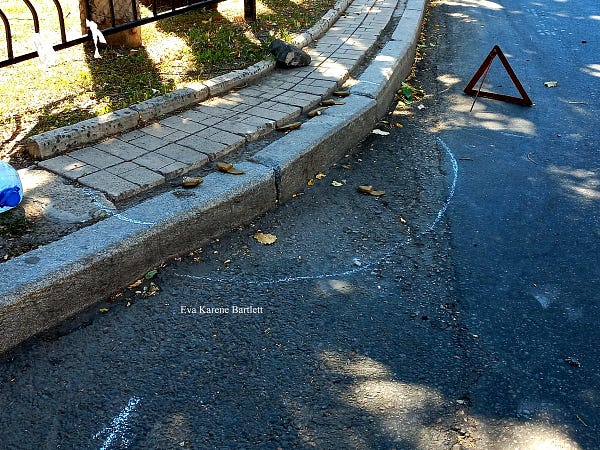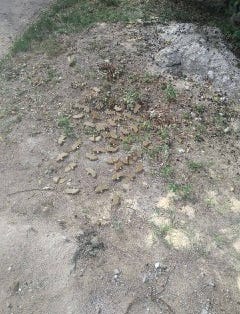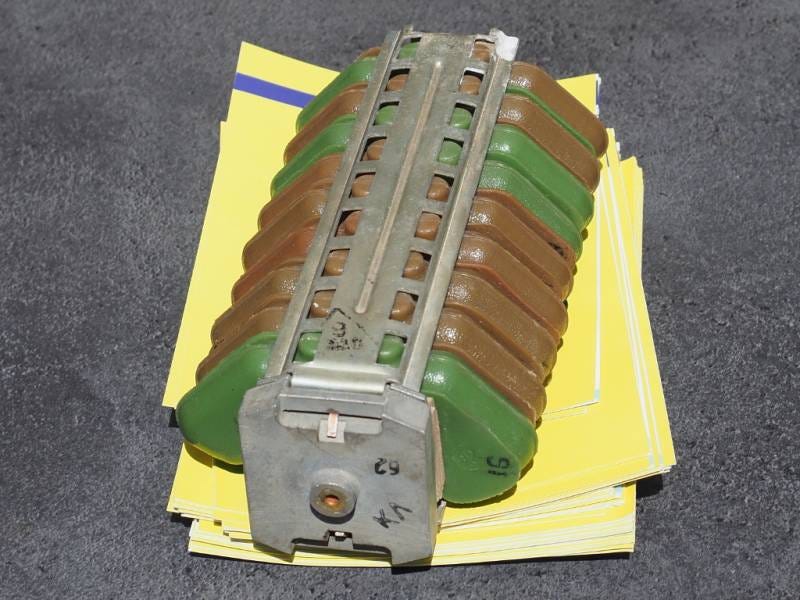Ukranian forces bombed residential streets of Donetsk littering them with anti-personnel "petal mines" Saturday night (July 30, 2022)
"This is pure Ukrainian genocidal terrorism."
Firstly, what are PFM-1 “petal” mines or bombs?
The concept and use of butterfly or petal bombs/mines appears to have been around since WWII.
The Dangers of Butterfly Bombs is a British (Reuters) public service announcement from 1943 “advising how to avoid and handle German anti-personnel (butterfly) bombs.”
The article, Ukrainian terror mines PFM-1 "Petal" published by Top War on July 22, 2022 provides a good historical overview of these sinister mines and their prohibitions for use. I have posted this article in full at the end of this blog. Of particular note is that by using the PFM-1 petal mines which it was required to destroy, Ukraine has violated both the Geneva Convention and its obligations under the Ottawa Convention.
In accordance with this document, she [Ukraine] was supposed to destroy stockpiles of PFM-1 and a number of other anti-personnel mines, but so far has not done so. Moreover, mines of this class have been actively used since 2014. At the same time, only PFM-1 mines without a self-liquidator are in service.
Of note is that on the 1st of August, Russia formally raised the issue of Ukraine’s use of the banned petal cluster mines against civilian targets, with the United Nation.
The Morningstar reported as follows:
“On August 1, we sent a letter to the UN secretary-general, Antonio Guterres, and to the president of the UN security council, Zhang Jun, containing additional information on Ukraine’s use of Lepestok mines against civilian targets in Donbass, with corresponding photo materials attached to it,” Russian UN representative Dmitry Polyansky said.
The cluster munitions, difficult to spot, are banned under international law, while their use is considered a war crime under the Geneva Convention.
Hundreds were scattered in residential areas in the city of Donetsk in the early hours of Sunday shortly after Ukrainian President Volodomyr Zelensky issued an urgent evacuation order.
More petal bombs were dropped during shelling of the city’s Kirov district today, according to locals. At least one civilian is said to have been injured.
Mines were also found on other streets, with local authorities highlighting them with spray paint and advising residents to stick to footpaths and remain vigilant.
The following paragraph is an excerpt from Eva’s op-ed for RT published August 2, 2022 which I posted earlier along with her videos in relation to the bombing of the Russian POW detention centre in Yelenovka where Azov milita members from Mariupal were being held.
The next morning, I went around Donetsk to document the extremely dangerous “petal” mines Ukraine has dropped on the city. According to DPR Emergency Services, eight civilians had been killed by these mines just the day before. If you step on one of these tiny-but powerful-explosives, chances it will merely tear off a leg instead of outright killing you. And they are insidiously toy-like in appearance, likely to attract children’s attention.
We first became aware of Ukraine’s use of the truly sinister butterfly or “petal mines'“ in the residential streets of Donetsk on Saturday, July 30th via Eva’s tweets. Her first tweet illustrates the horrific damage caused when someone steps on one. I shudder to think what would happen if a child or a pet stepped on one of these. The consensus is that they would no longer be with us.
These are some of Eva’s tweets from Saturday night, 30th July with a few select replies.






Eva has also posted today the following videos of Russian forces removing the petal mines from the residential streets of Donetsk.
The use of PFM-1 ‘butterfly’ mines against civilians is prohibited by the Geneva conventions – but this evidently isn’t stopping Ukraine Saturday night [30th July], just after 9 pm, thunderous explosions rocked central Donetsk. Shortly after, there were announcements that air defense had shot down Ukrainian-fired missiles containing “Butterfly” (or “Petal”) mines. Given that over 300 of these mines are packed into each of the Ukrainian-fired rockets, central Donetsk would literally be a minefield. While Ukraine has been using these mines on the Donbass for many months, in recent days they have intensely bombarded Gorlovka and Donetsk neighbourhoods with them. Initially targeted were the hard-hit districts of Kievskiy in the north, Kirovsky in the southwest, and Kuibyshevkiy in the west. But as of Saturday night, Ukraine hammered central Donetsk with them. And now, walking in the city centre is a nightmare, one I had to endure to document how widespread these mines are here: in central streets and walkways, near apartments, in parks...
As Eva quotes Dmitry Astrakhan, press officer for the DPR People’s Militia:
❝This is pure Ukrainian genocidal terrorism.❞
Eva’s description for her second video:
On July 30, in a densely inhabited working-class district of western Donetsk, in a field with garden plots for nearby apartment residents, I saw the nefarious "petal" or "butterfly" mines which Ukraine the following day dropped on the central of Donetsk. In the large courtyard of an apartment complex, I watched from a safe distance as Emergency Services timer-detonated eight mines they had found around the grounds. The day prior, they destroyed 26. Another 150 were located and destroyed using a radio-controlled minesweeper. But there remains much work to restore the streets and courtyards to safety. Some types of these anti-personnel mines have a self-destruct timer. Others, including the ones Ukraine is firing, have a years-long shelf life. They do pretty much no damage to military vehicles, and as such their use in Donbass is insidious – deliberately targeting civilians, to leave them maimed. Out of the 6 million such mines Ukraine initially declared in its possession, only 2 million have been reportedly destroyed as of 2018.
This is Roman Kosarev’s report for RT on the use of the banned petal mines in Donetsk, published July 31, 2022.
Russian-led forces de-activate prohibited anti-personnel PFM-1 'Petal' mines which Ukrainian troops launched in great numbers in Donetsk and nearby residential areas.
At the start of this Military Summary video the analyst describes the petal mines on the ground in Donetsk and shows the cartridges they come in. Whilst describing the military situation in Ukraine as of the 31st of July, he alludes to the possibility that the petal mine attack on Donetsk may have shifted the Russian military plan.
Ukraine. Military Summary And Analysis 31.07.2022
Today in the Donetsk:
This is not good, to put it mildly. Heavy rain and flooding could compound the problem with those sinister petal mines floating around and ending up, who knows where.
I do not know about the veracity of this but the title of the video states that it’s “the exact moment UAF deployed PFM-1 Petal mines on central Donetsk.”
This is the Top War article which I referenced near the start regarding its historical overview of these absolutely sinister anti-personnel petal munitions, replicated in full.
Ukrainian terror mines PFM-1 "Petal"
July 22 2022
Ukrainian mine PFM-1 in Lisichansk. Photo Telegram / Poddubny
The retreating Ukrainian armed formations are mining the area and various objects. For this, various types of ammunition and means of their installation are used. In particular, the active use of high-explosive anti-personnel mines PFM-1 is reported. Products of this type pose a great danger to the civilian population, and their use violates international agreements.Threats in the city
The first reports of the use of PFM-1 mines by Ukraine appeared in mid-March. With the help of such weapons tried to create barriers in the path of the advancing troops. The setting was carried out using special shells for the Uragan MLRS with a cluster warhead carrying 312 mines. However, such minefields did not create any particular obstacles and did not stop a successful offensive, although they added work to our sappers.
Subsequently, in the liberated territories, new areas were repeatedly noticed, "sown" with light anti-personnel mines. It was necessary to search for and neutralize such ammunition both in open areas and on the territory of settlements.
Recently, the allied forces liberated the cities of Lisichansk and the city of Yasinovataya, and a large number of PFM-1 products were found on their territory. Mines lay on the streets, in yards, in green spaces, etc. Our military correspondents reported that they had never seen such a density of mining in populated areas.A couple of mines in urban areas. Photo Telegram / Colonelcassad
Such "obstacles" within the boundaries of the settlement are of particular danger. Local residents do not have the necessary training and cannot detect a mine in time or identify an explosive device in it. In addition, children may be interested in an unusual object lying on the surface. As a result, several residents were blown up and left disabled. However, Russian engineering units immediately began searching for and neutralizing dangerous objects.
Mine in service
The anti-personnel high-explosive mine PFM-1 was developed in the early seventies based on a foreign sample. The American mine BLU-43 / B Dragontooth became a model for copying. The latter was created in the mid-sixties and was intended for the rapid remote creation of minefields. This weapon did not perform well in the jungle, and already in 1970-71. he was refused.
American mines came to the USSR, were studied and interested in the Soviet army. It was decided to create their own version of such ammunition based on the same ideas and solutions, but with some design changes. The result of these works was the PFM-1 mine, also known as the Petal. In addition, remote mining tools were created for its use. They entered service with the engineering troops, rocket artillery, as well as the army and front aviation.
Soviet mines were produced in large quantities and sent to various parts. Since the beginning of the eighties, these weapons have been actively used in Afghanistan on the enemy's movement routes or near his positions. The open mountainous terrain proved to be a convenient theater for the use of such mines, and they showed good results. Later PFM-1 was used in various local conflicts in the post-Soviet space. In particular, with their help, federal forces fought militants in the North Caucasus.
In 1996, the so-called. Protocol II to the Geneva Convention on Conventional Weapons, which introduced a number of new restrictions. In particular, this determined the permissible methods of using mine weapons, and also prohibited the use of mines without the function of self-deactivation or elimination.Ammunition at the Yasinovataya railway station. Photo Telegram / Rudenko
The PFM-1 mine in the basic version does not have the function of self-detonation within a specified period. In this regard, the Russian army, fulfilling the requirements of the Protocol, removed such mines from service and disposed of them. Only the newer PFM-1S, equipped with self-liquidators, remained in the arsenals. At the same time, products of the first option remained in the armies of the near abroad.
According to known data, at the beginning of the tenth years, at least 6 million PFM-1 mines were in the warehouses of the Ukrainian army. As part of the implementation of the Protocol and the Ottawa Convention, since 2013, with the assistance of NATO and the European Union, their disposal has been carried out. However, its pace remained insufficient, and until now Ukraine has a large number of mines and cartridges with them. As is now known, they are actively used by armed formations.Conventions and their violation
By using anti-personnel mines PFM-1, Ukraine not only poses a threat to the civilian population, but also violates several conventions and treaties. In fact, we are talking about war crimes. And the allied forces are taking measures aimed at identifying and punishing those responsible.
First of all, Ukraine violates its obligations under the Ottawa Convention. In accordance with this document, Ukraine was supposed to destroy stockpiles of PFM-1 and a number of other anti-personnel mines, but so far has not done so. Moreover, mines of this class have been actively used since 2014. At the same time, only PFM-1 mines without a self-liquidator are in service. Their existence and use also violate Protocol II of the Geneva Convention.
Remote laying of mines in the territory of a settlement in which the population is present can be considered as the use of indiscriminate weapons. This directly violates the terms of the IV Geneva Convention for the Protection of Civilian Persons. The Uragan MLRS used to launch mines are also non-selective systems.Clip with products PFM-1S, designed to be loaded into the cassette. Photo by Wikimedia Commons
Finally, the use of anti-personnel mines in cities with residents who could be affected by them is simply immoral. A special aspect of this situation is given by the fact that settlements that the Kyiv regime considers to be their’s are being mined. However, when retreating, they immediately begin to fire and / or mine.
It is easy to see that violations of international law related to the use of PFM-1 mines or any other weapon go unnoticed by the notorious "international community". Foreign advocates of morality and legality prefer to discuss fictitious violations on the Russian side, but do not pay attention to the real crimes of Ukrainian formations. The reasons for this are obvious, and, unfortunately, there are no prerequisites for changing this situation.Explosive "Petal"
The PFM-1(S) is a push-pull anti-personnel mine designed for remote mining systems. This product is 116 mm long, 64 mm wide and 20 mm thick, weighing only 80 g. The mine is made in a characteristically shaped polyethylene case. There are two "wings", one of which is the capacity for the charge, and the other acts as a stabilizer when falling. Between them is a thickening with a fuse.
The mine is equipped with a fuse of the MVDM type, which includes a long-range cocking mechanism and a safety system. In the PFM-1S product, the fuse is supplemented with a self-liquidator with an action time of 1 to 40 hours. There is no separate target sensor for the mine. Its functions are performed by the side wing-balloon, which contains 40 g of liquid explosive. When you press the cylinder with a force of 10-25 kg, the liquid flows into the cavity of the fuse and causes it to work.
Products PFM-1(S) are used with KSF-1 cassettes of several options for ground and air remote mining systems. Each cassette holds up to 72 mines and throws them at a distance of up to 30-35 m. Mines can also be placed using the Uragan MLRS and the 9M27K3 projectile - it carries 12 cassettes with 312 mines and scatters them over a large area.Cluster warhead of a 9M27K3 rocket. Some of the cassettes have been removed for clarity. Photo Russianarms.ru
Mines PFM-1 (C) are distinguished by specific combat qualities. Shape and color contribute to camouflage on the ground; a minimum of metal parts makes it difficult to detect by technical means. 40 g of liquid explosive can cause serious damage to the health of an adult, up to traumatic amputation of a limb. Such a mine will simply kill a child.
Fortunately, the fight against these mines is not a fundamental problem. In open areas, the minefield is neutralized by various trawls, elongated charges and other means. In other cases, PFM-1 is destroyed using an overhead charge in compliance with all safety measures. At the same time, the absence of a self-liquidator on the Ukrainian PFM-1 eliminates the sudden detonation of the product and reduces the risks for sappers.Crime and Punishment
The observed situation with anti-personnel mines once again shows the dubious moral principles and habits of the current Kyiv regime and its armed formations. They do not hesitate to choose methods and means of "armed struggle" and are ready to inflict any damage on settlements, which they consider to be their property.
Fortunately, the Russian army and militia of Donbass are taking the necessary measures to protect the inhabitants and to eliminate the consequences of Ukrainian activities. In parallel with this, the relevant authorities collect the necessary data and conduct an investigation. And it should be expected that those who used mines on peaceful cities and violated conventions will be held accountable or even eliminated.



















